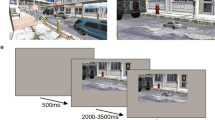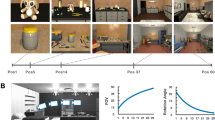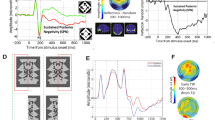Abstract
Attention depends on figure-ground organization: figures draw attention, whereas shapes of the ground tend to be ignored. Recent research has revealed mechanisms for figure-ground organization in the visual cortex, but how these mechanisms relate to the attention process remains unclear. Here we show that the influences of figure-ground organization and volitional (top-down) attention converge in single neurons of area V2 in Macaca mulatta. Although we found assignment of border ownership for attended and for ignored figures, attentional modulation was stronger when the attended figure was located on the neuron's preferred side of border ownership. When the border between two overlapping figures was placed in the receptive field, responses depended on the side of attention, and enhancement was generally found on the neuron's preferred side of border ownership. This correlation suggests that the neural network that creates figure-ground organization also provides the interface for the top-down selection process.
This is a preview of subscription content, access via your institution
Access options
Subscribe to this journal
Receive 12 print issues and online access
$209.00 per year
only $17.42 per issue
Buy this article
- Purchase on Springer Link
- Instant access to full article PDF
Prices may be subject to local taxes which are calculated during checkout







Similar content being viewed by others
References
Rubin, E. Visuell wahrgenommene Figuren (Gyldendals, Copenhagen, 1921).
Koffka, K. Principles of Gestalt Psychology (Harcourt, Brace and World, New York, 1935).
Nakayama, K., Shimojo, S. & Silverman, G.H. Stereoscopic depth: its relation to image segmentation, grouping and the recognition of occluded objects. Perception 18, 55–68 (1989).
Driver, J. & Baylis, G.C. Edge-assignment and figure-ground segmentation in short-term visual matching. Cognit. Psychol. 31, 248–306 (1996).
Zhou, H., Friedman, H.S. & von der Heydt, R. Coding of border ownership in monkey visual cortex. J. Neurosci. 20, 6594–6611 (2000).
Qiu, F.T. & von der Heydt, R. Figure and ground in the visual cortex: V2 combines stereoscopic cues with Gestalt rules. Neuron 47, 155–166 (2005).
Qiu, F.T. & von der Heydt, R. Neural representation of transparent overlay. Nat. Neurosci. 10, 283–284 (2007).
Motter, B.C. Focal attention produces spatially selective processing in visual cortical areas V1, V2 and V4 in the presence of competing stimuli. J. Neurophysiol. 70, 909–919 (1993).
Reynolds, J.H., Chelazzi, L. & Desimone, R. Competitive mechanisms subserve attention in macaque areas V2 and V4. J. Neurosci. 19, 1736–1753 (1999).
Luck, S.J., Chelazzi, L., Hillyard, S.A. & Desimone, R. Neural mechanisms of spatial selective attention in areas V1, V2 and V4 of macaque visual cortex. J. Neurophysiol. 77, 24–42 (1997).
Bender, D.B. & Youakim, M. Effect of attentive fixation in macaque thalamus and cortex. J. Neurophysiol. 85, 219–234 (2001).
Marcus, D.S. & Van Essen, D.C. Scene segmentation and attention in primate cortical areas V1 and V2. J. Neurophysiol. 88, 2648–2658 (2002).
Friedman, H.S., Zhou, H. & von der Heydt, R. The coding of uniform color figures in monkey visual cortex. J. Physiol. (Lond.) 548, 593–613 (2003).
Motter, B.C. Neural correlates of feature selective memory and pop-out in extrastriate area V4. J. Neurosci. 14, 2190–2199 (1994).
Schütze, H., Niebur, E. & von der Heydt, R. Modeling cortical mechanisms of border ownership coding. J. Vis. 3, 114 (2003).
Craft, E., Schütze, H., Niebur, E. & von der Heydt, R. A neural model of figure-ground organization. J. Neurophysiol. 97, 4310–4326 (2007).
Intriligator, J. & Cavanagh, P. The spatial resolution of visual attention. Cognit. Psychol. 43, 171–216 (2001).
Girard, P., Hupe, J.M. & Bullier, J. Feedforward and feedback connections between areas V1 and V2 of the monkey have similar rapid conduction velocities. J. Neurophysiol. 85, 1328–1331 (2001).
Goldberg, M.E., Bisley, J.W., Powell, K.D. & Gottlieb, J. Saccades, salience and attention: the role of the lateral intraparietal area in visual behavior. Prog. Brain Res. 155, 157–175 (2006).
Lamme, V.A.F. The neurophysiology of figure-ground segregation in primary visual cortex. J. Neurosci. 15, 1605–1615 (1995).
Zipser, K., Lamme, V.A.F. & Schiller, P.H. Contextual modulation in primary visual cortex. J. Neurosci. 16, 7376–7389 (1996).
Lee, T.S., Mumford, D., Romero, R. & Lamme, V.A.F. The role of the primary visual cortex in higher level vision. Vision Res. 38, 2429–2454 (1998).
Mack, A., Tang, B., Tuma, R., Kahn, S. & Rock, I. Perceptual organization and attention. Cognit. Psychol. 24, 475–501 (1992).
Moore, C.M. & Egeth, H. Perception without attention: evidence of grouping under conditions of inattention. J. Exp. Psychol. Hum. Percept. Perform. 23, 339–352 (1997).
Driver, J., Davis, G., Russell, C., Turatto, M. & Freeman, E. Segmentation, attention and phenomenal visual objects. Cognition 80, 61–95 (2001).
Connor, C.E., Preddie, D.C., Gallant, J.L. & Vanessen, D.C. Spatial attention effects in macaque area V4. J. Neurosci. 17, 3201–3214 (1997).
Grossberg, S. How does a brain build a cognitive code? Psychol. Rev. 87, 1–51 (1980).
Desimone, R. & Duncan, J. Neural mechanisms of selective visual attention. Annu. Rev. Neurosci. 18, 193–222 (1995).
Schiller, P.H. The effects of V4 and middle temporal (MT) area lesions on visual performance in the rhesus monkey. Vis. Neurosci. 10, 717–746 (1993).
Acknowledgements
We wish to thank T.J. Macuda for help with the behavioral training of monkey TE; S. Mihalas, E. Niebur, P.J. O'Herron and N.R. Zhang for suggestions and critical comments on the manuscript and O. Garalde for technical assistance. This research was supported by US National Institutes of Health grants EY02966 and EY16281.
Author information
Authors and Affiliations
Corresponding author
Supplementary information
Supplementary Text and Figures
Supplementary Figures 1–5 (PDF 263 kb)
Rights and permissions
About this article
Cite this article
Qiu, F., Sugihara, T. & von der Heydt, R. Figure-ground mechanisms provide structure for selective attention. Nat Neurosci 10, 1492–1499 (2007). https://doi.org/10.1038/nn1989
Received:
Accepted:
Published:
Issue Date:
DOI: https://doi.org/10.1038/nn1989
This article is cited by
-
Cognitive penetrability of scene representations based on horizontal image disparities
Scientific Reports (2022)
-
Space between products on display: the impact of interspace on consumer estimation of product size
Journal of the Academy of Marketing Science (2021)
-
Attentional selection and illusory surface appearance
Scientific Reports (2019)
-
Common spatiotemporal processing of visual features shapes object representation
Scientific Reports (2019)
-
Visual brain plasticity induced by central and peripheral visual field loss
Brain Structure and Function (2018)



